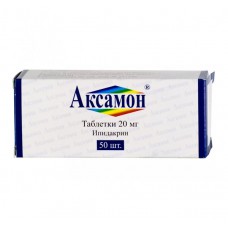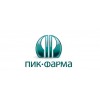Expiration date: 06/2026
The composition and form of issue:
Tablets. 1 tablet contains active substance:
ipidakrin hydrochloride monohydrate (Axeman) 20 mg
(in terms of ipidakrina hydrochloride)
excipients: ludipress (lactose monohydrate 93% with povidone 3.5 percent, crospovidon 3,5%) — 65 mg carboximetilkrahmal sodium — 14 mg calcium stearate 1 mg
in a contour acheikova packing of PVC film and aluminum foil 10 PCs. in cardboard pack 5 packs or in jars of dark glass with screw neck, sealed plastic screw-on lids, or plastic with lid 50 PCs the paper cartons 1 Bank.
Description pharmaceutical form:
Round flat white pill with a chamfer.
Pharmacokinetics:
The drug is rapidly absorbed after administration inwards. Cmax in the blood is achieved through 25-30 minutes after intake of low-dose and 1 hour after a dose of 10 mg/kg. Examon quickly penetrates from the blood into tissue, and after reaching the equilibrium state in blood serum is about 2% of the drug. T1/2 is 0.7 hours, About 40-55% of the drug binds to serum proteins. Entering into Examon absorbed mainly from the duodenum, to a lesser extent, of thin and podvzdoshnoj guts, only 3% of the dose is absorbed in the stomach. Partially biotransformiroetsa and eliminated from the body with the participation of renal and extrarenal (secretion of bile) mechanisms. Excretion of the drug by the kidneys is mainly due to the secretion in the tubules and only 1/3 of drug excreted by glomerular filtration. Only 3.7% of the drug excreted in the urine unchanged.
Description pharmacological action:
Axeman — a reversible cholinesterase inhibitor. Due to the blockade of cholinesterase enhances the action of acetylcholine on m- (activated phospholipase) and n (increases the current of Na+ ions into the cell) receptors. Stimulates impulse conduction in the CNS. Leads to improved memory functions. Improves conductivity in the peripheral nervous system and stimulates neuromuscular transmission. Axeman enhances the action on the smooth muscle of acetylcholine, adrenaline, serotonin, histamine and oxytocin and contractility of smooth muscle organs.
Indications:
- diseases of the peripheral nervous system (neuritis, polyneuritis and polyneuropathy, polyradiculoneuropathy)
- bulbar paralysis and paresis
- organic CNS lesions accompanied by motor disorders (in rehabilitation period)
- myasthenia gravis and myasthenic syndromes different
- complex therapy of demyelinating diseases
- Alzheimer's disease and senile dementia of Alzheimer's type
- atony of the intestine.
Contraindications:
- hypersensitivity
- epilepsy
- extrapyramidal disorders, hyperkinesis
- angina
- bradycardia
- bronchial asthma
- the tendency to vestibular disorders
- pregnancy
- lactation.
Application of pregnancy and breast-feeding:
Contraindicated in pregnancy. At the time of treatment should stop breastfeeding.
Side effects:
The drug is well tolerated, side effects are rare (6.5% of cases), mild and usually do not require discontinuation of the drug.
From the digestive system: anorexia, hypersalivation, nausea, vomiting, increased peristalsis, diarrhea, jaundice.
From the nervous system: dizziness (after reintroduction), ataxia.
Allergic reactions: skin itching, rash.
Other: bronchospasm, bradycardia.
Drug interactions:
Enhances sedative effect of oppressive Central nervous system, including alcohol, the effects of other cholinesterase inhibitors and m-cholinomimetics.
Compared to other cholinomimetic funds increases the risk of a cholinergic crisis in patients with myasthenia gravis.
Beta-blockers enhance the bradycardia.
Reduces the effect of local anesthetics, antibiotics.
Atropine and iodide metazine reduce the severity of symptoms of overdose.
Method of application and dose:
Inside. Dose and duration of treatment is determined individually, depending on the severity of the disease.
Diseases of the peripheral nervous system, myasthenia gravis, myasthenic syndrome: 10-20 mg 1-3 times a day. The course of treatment — from 1 to 2 months. If necessary, the treatment can be repeated several times with a break between courses of 1-2 months.
Alzheimer's disease, encephalopathy, recovery period of organic CNS diseases accompanied by movement disorders, including bulbar paralysis and paresis: the daily dose is selected individually, usually 10-20 mg 2-3 times a day.
In demyelinating lesions of the nervous system, the dose can be increased to 20-40 mg 5-6 times a day. Maximum daily dose of 200 mg.
If one of the techniques was omitted, the following method is adopted the usual dose of the drug.
Overdose:
Treatment: in overdose relative Examina — withdrawal of the drug, the purpose of m-holinoblokatorov (atropine sulfate, trihexyphenidyl).
Precautions:
With caution should be appointed with gastric ulcer, thyrotoxicosis, diseases of the cardiovascular system it is necessary to consider the ability of the drug to increase uterine tone.
It should not be used during the drivers of vehicles and people whose work is associated with increased concentration.
During treatment should abandon admission alcohol.


